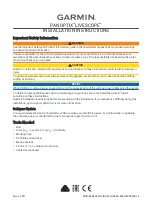
Cool Line
®
Intravascular Heat Exchange Catheter (Custom Luer)
Instructions for Use
CL-2295A/8700-0781-01
106476-001
Revision 5
1 of 10
ZOLL
Caution: Federal law restricts this device to sale by or on
the order of a physician.
Model CL-2295A/8700-0781-01 (Also referred to as CL-
2295)
includes:
Quantity
Description
1
Cool Line
®
Catheter
9.3 French x 22 cm
Tri Infusion Luer
Extension Line Clamps
Radiopaque Shaft
Applause Heparin Coated
2
Guidewires .032" (0.81 mm) x 65 cm
1
Vessel Dilator 10.5F x 0.38”
(3.6 mm x 1.0 mm)
1
Detachable Suture Tab & Clip
1
18 ga x 2 ½" (1.3 mm x 6.4 cm) Radiopaque
PTFE OTN Catheter
Catheter
1
000 Silk Suture
1
Chloraprep
®
Triple Swabstick Prep Pack
6
4" x 4" (10 cm x 10 cm) Gauze Sponges
1
No. 11 Surgical Blade w/ long handle
1
3 cc Syringe and 25 ga x 1" (0.5 mm x 2.5 cm)
Needle
2
5 cc Syringes and 22 ga x 1 ½” (0.7 mm x
38
mm) Needles
1
Fenestrated Drape
1
18 ga x 2 ¾" (1.3 mm x 67 mm) Needle
1
Needle Disposal Cup
1
SilvaSorb
®
Site Antimicrobial Dressing
1
Suresite
®
Transparent Film Dressing
Device Description
The Cool Line Intravascular Heat Exchange Catheter (“Cool
Line Catheter” or “catheter”) is a sterile, single use flexible
9.3 F catheter designed for placement in the central venous
circulation from an insertion site in the jugular, subclavian, or
femoral veins. The Cool Line Catheter is to be connected to a
single use, disposable Coolgard 3000
®
/Thermogard XP
®
Start-
Up Kit (supplied separately) and the Coolgard
3000/Thermogard XP System. A dilator and guidewire are
required for the percutaneous insertion of the Cool Line
Catheter. Three Luers are available for infusion, measuring
central venous pressure or sampling.
Infusion Port
Size
Flow Rate
Priming
Volume
Proximal Port
(blue)
18 Ga
1400 ml/hr
0.3 cc
Medial Port
(white)
18 Ga
1200 ml/hr
0.3 cc
Guidewire Port
(brown)
16 Ga
2100 ml/hr
0.4 cc
Insertion size:
Model CL-2295
9.3F
The Cool Line
Catheter blood contact surfaces (tip, balloon, and
shaft) are treated with an anti-thrombotic Applause heparin
coating.
Sterility
Ethylene oxide sterilized. The Cool Line
Catheter is supplied
sterile for single use only and should not be resterilized. The
package should be inspected prior to use to ensure that the
sterility barrier has not been compromised.
Storage
Store between 20-25°C. Avoid freezing and excessive heat
above 40°C.
Indications for Use
The Cool Line
Catheter Model CL-2295A, when used with the
ZOLL Thermal Regulation System is indicated for use in fever
reduction, as an adjunct to other antipyretic therapy, in adult
patients with cerebral infarction and intracerebral hemorrhage
who require access to the central venous circulation and who
are intubated and sedated.
Safety and Efficacy Considerations
Central venous catheterization should only be performed by
well-trained personnel well-versed in anatomical landmarks
and safe technique. Personnel should also have knowledge of
potential complications. The product is designed for single use
only. Do not resterilize or reuse. Do not reinsert, once removed
from the patient. Do not alter the catheter in any way.
Potential risks with reuse of a single-use device include but are
not limited to
•
Potentially life threatening infection
•
Toxic shock due to degradation of materials
•
Increased risk of thrombosis
•
Reduced heat exchange power
•
Device failures
WARNING: Do not allow the catheter to be placed into
the right atrium or right ventricle. Placement in the right
atrium or right ventricle can result in severe patient
injury or death.
Contraindications
1.
The risks of the catheter are essentially those of a central
line. The catheter should not be used in patients for
whom central line placement is not indicated.
2.
Bleeding diathesis.
3.
Active sepsis.
4.
Infection or active bleeding at the site of catheter
insertion.
5.
Patients with no vascular access, or a vascular system
will not accommodate a catheter. Patients for whom the
required temperature monitoring cannot be established.
Warning – Fever Reduction
The safety of this device has not been demonstrated
for fever reduction in patients presenting with
subarachnoid hemorrhage or primary traumatic
brain injury. The safety and effectiveness of this
device was examined in a randomized controlled
trial of 296 patients. The mortality results reported
in this trial, for the four patient cohorts enrolled, are
presented in the table below (CI – cerebral
infarction, ICH – intracerebral hemorrhage, PTBI –
primary traumatic brain injury, SAH –
subarachnoid hemorrhage).
Mortality by Diagnosis (ITT analysis)
Cool Line
Control
n
N
%
n
N
%
p*
CI
3
16
18.8
3
14
21.4
0.74
ICH
8
33
24.2
7
27
25.9
1.00
PTBI
10
44
22.7
4
38
10.5
0.24
SAH
13
61
21.3
7
63
11.1
0.15
*Fischer’s exact test
For more details on the clinical trial results, refer to
the Physician’s Manual – “Normothermia for the
Neuro- critically Ill stroke patient”.




























